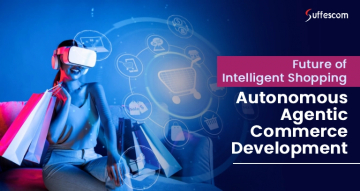How To Increase Ecommerce Revenue With Metaverse Technology?

The entire existence of e-commerce business centers around consumers. Every strategy begins from the customer’s vantage point, from how they behave and what they buy to how to get their attention.
As we are moving into the new era of 2024, the e-commerce giants monitoring the movement and behavior of consumers cannot overlook the mergence of tech into consumer behavior. The most prominent among these is metaverse technology.
“...by 2026, 25% of people will spend at least one hour per day in the Metaverse.” - Gartner
Modern consumers expect businesses to move beyond the 2D shopping experience and create a 3D, immersive experience. Why? For the simple reason that virtual e-commerce makes shopping easier.
So, what does it mean for your e-commerce business? Should you consider jumping into the metaverse trend? And if yes, how?
While the metaverse may be an overwhelming concept for non-technical business owners, it is one technology that can help increase e-commerce revenue when implemented the right way.
Build A Metaverse Try On App For Your Business
Make shopping more effective for your users with a metaverse try on app. Discuss the process with our experts today.
Suffescom Solutions is here to help you understand how Metaverse can eliminate multiple pain points of e-commerce businesses.
Highlights of Metaverse Use Cases in E-commerce
- Build an e-commerce store in the metaverse.
- Provide virtual product demonstrations.
- Boost user satisfaction and increase ROI.
- Support informed decisions and reduce the product return rate.
- Enhance personalized shopping.
- Gamify online shopping
The V-Commerce Trend - Is It Worth The Investment?
V-commerce or virtual commerce is the term that sprung up, considering the popularity of virtual and immersive shopping. Unlike conventional e-commerce platforms, v-commerce utilizes virtual reality, 3D technology, and augmented reality. The end goal is to make virtual shopping possible for consumers.
The shift into the virtual commerce space is gradual, however profitable. Here are a few numbers that explain why you should consider using Metaverse in e-commerce.
- With a CAGR of 36.62, the market value of Metaverse E-commerce is expected to reach US$201.80bn by 2030. (Statista)
- User penetration is expected to increase by 5.7 percent between 2023 and 2030.
Source: Statista
Key E-commerce Challenges And Its Metaverse Solution
The e-commerce industry can state multiple reasons behind a downfall in annual revenue. But there’s a metaverse solution to the problems. Let’s look at a few ways metaverse technology can help ease the key challenges of e-commerce businesses.
Reduced Product Return Rate
15% to 40% of all online purchases are returned. And in most cases, the returned items end up in a landfill. Above all, the business incurs a loss of as much as 59% of the original price. The most common reasons for product returns are size issues, color differences, unmet expectations, quality issues and defects.
So, how can metaverse technology solve this issue?
By creating a 3D, interactive experience of the products.
For an e-commerce apparel store, a virtual try on app will help consumers make more informed decisions. The app uses AR technology to lay the products on the consumers in the real world, allowing them to see how it looks. The app can also be used for other e-commerce businesses like home decor, furniture, etc.
Similarly, metaverse e-commerce store development allows businesses to create 360° product reviews and displays. It guides customers to make more informed decisions, reducing the product return or exchange rate.
How To Boost Ecommerce Revenue With Metaverse?
Join the metaverse space and enhance your business growth. Talk to our experts today and create your metaverse ecommerce store today.
Real Time Customer Support
Customer support service is where a customer can become loyal or turn the other way and never look back. Not all methods of traditional customer support work in a metaverse platform. However, the new technology does let businesses explore new elements, such as AI chatbots and 3D avatars.
41% of consumers prefer real time customer support over emails or calls. And AI powered customer services in a metaverse store help provide real time solutions that are also more realistic.
Easy And Reliable Cross Border Purchases
International stores shipping worldwide often run the risk of customer disappointment. However, e-commerce stores can adapt the metaverse technology to connect the virtual and the physical.
Whether it’s virtual try rooms, digital twins of the physical store or virtual demonstrations of products, consumers easily make cross border purchases. They have a real experience through the VR device and can safely and confidently buy from international stores.
Personalized and Accurate Search Engine
Most e-commerce purchases start from the search bar. However, 72% of all sites fail to meet users' search queries. The problem starts from the inability of the e-commerce search engines to meet the search input. The results are generally based on keywords that are not often very descriptive. All of it leads to a poor user experience.
The Metaverse technology offers a few solutions to this problem.
AI-powered metaverse e-commerce stores can make product search more efficient. AI can make recommendations and show results that best match the search query. Additionally, businesses can create virtual product demonstrations. These demonstrations eliminate the restriction of a specific word count or space and allow for the addition of more insights. It helps users navigate the virtual store and find exactly what they want.
Exciting Loyalty Rewards As NFTs
Loyalty programs are an effective customer retention strategy, however, there’s a need to offer more than just reward points.
E-commerce loyalty programs can create their own NFTs of tokens to begin an NFT loyalty program in the metaverse. Besides offering long term value, NFT loyalty programs create a better customer retention and loyalty strategy.
Gamified Advertising Campaigns
It’s hard for e-commerce brands to stand out in the crowd. Gamification of advertising campaigns can help in this case. Brands can use reward-based systems, have a Q&A session, make product demonstrations interactive and much more. The possibilities are endless.
4 Popular Brands Advocating Metaverse in E-commerce in 2024
Nike
Nike introduced NIKELAND on Roblox back in 2021. The platform was designed to allow users to play, socialize and purchase Nike products from virtual stores. The move into the metaverse benefitted the brand as they gained 7 million users globally within 4 months of launching NIKELAND.
Coca Cola
With a proper launch and marketing strategy, Coca-Cola launched its collection of NFTs to raise funds for charity. The company was able to successfully raise about $5000.000 in a matter of 72 hours.
Gucci
Gucci partnered with Roblox to create a 2-week long virtual exhibition of rare Gucci items. Needless to say, the exhibition was a success since Gucci sold one of its bags for $4115, which is $715 more that the retail value of the physical bag.
Samsung
Samsung released a replica of its New York store in the virtual world of Decentraland back in 2022. The purpose was to allow customer interaction with products and gamification of the shopping experience. The platform has since gained 120,000 customers.
Looking For The Best Way to Take Your E-commerce Business Into The Metaverse?
Talk to our experts and have a free consultation today. We will determine the best way to make your e-commerce business successful in the virtual space.
What Is The Future Of Metaverse in E-commerce?
The future of metaverse in e-commerce is bright and profitable. From additions of new elements to modernizing shopping for customers, metaverse can help increase revenue in multiple ways.
Considering the rising demand for convenient experiences, virtual e-commerce will only grow from here. Get in touch with the tech team at Suffescom Solution to get the best metaverse solution to increase your e-commerce business revenue.







